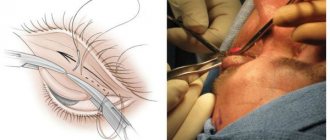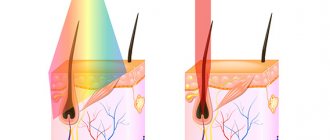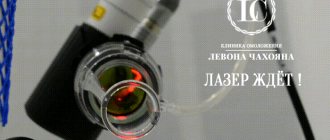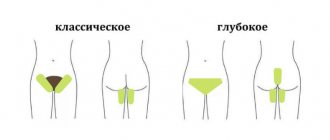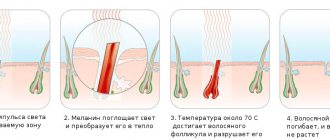The choice between photoepilation and laser hair removal often leads to a dead end - the short descriptions of the techniques are similar, it is difficult to make a choice for a simple reason - the meaning of the operation of the devices is incorrectly presented. Both methods are based on the use of a light beam, but in the first case it comes from high-energy lamps, and in the second it comes from laser radiation.
Let's look at the difference between photoepilation and laser hair removal, what principle they work on, the advantages, disadvantages and features of the technologies.
What is laser hair removal
Laser hair removal is considered a more progressive method of hair removal. It works on the same principle as photoepilation, but differs in the local spectrum of action. The energy of a narrow laser beam extends to an area of the body and affects a specific type of hair - even if its color matches the color of the skin. Heating the follicle leads to the absorption of melanin, after which the hair’s nutrition stops ().
One pulse takes a fraction of a second, and its effect extends over an area from 3 to 10 square meters. cm. The laser action covers a smaller area, so the laser therapy session lasts longer. However, the positive effect is not visible immediately, but after several weeks. This is normal - the intervals between sessions at the initial stage are 1-2 months. In the future, they are increased at the discretion of the cosmetologist.
Cost of hair removal using different types of devices
Diode laser hair removal is considered one of the most expensive types of hair removal. At the same time, the cost of hair removal with such a device for a bikini line in the capital’s beauty salons is on average 5,000 rubles, for the upper lip – 1,500 rubles, for legs – 15,000 rubles.
Hair removal using a photoepilation machine averages 3,000 rubles for the bikini area, 2,000 rubles for the upper lip, and hair removal for both legs is estimated at approximately 8,000 rubles.
Using an elos hair removal machine, you can remove hair from the bikini line for about 2,200 rubles, from the upper lip - for 500 rubles, from the surface of the legs - for 3,000 rubles.
Flaws:
high price;
side effects in the form of an unpleasant tingling sensation;
possibility of burns;
need for pain relief;
no effect on light, gray hair;
allergic reactions are possible;
Pigmentation is possible on tanned skin.
Most modern lasers have all the advantages of photoepilation, but there are fewer disadvantages, including higher efficiency when epilating light hair, and a significantly lower likelihood of burns ().
Contraindications and complications of procedures
How does laser hair removal differ from photoepilation in terms of contraindications and complications? Yes, practically nothing. They have the same contraindications:
- Pregnancy and breastfeeding;
- Diabetes;
- Hypertension and ischemia;
- Inflammations on the skin;
- The presence of lesions or malignant neoplasms on the skin;
- Children and adolescents (not recommended for those under 17-18 years old);
- Gray or very light hair and very dark skin.
Complications, in principle, are also similar, since both types of hair removal have similar mechanisms of action on the treated surface. Complications may include:
- Burns;
- Allergic reactions;
- The appearance of scars and changes in skin pigmentation;
- Conjunctivitis, blurred vision.
List of contraindications
Both procedures are considered safe in the absence of systemic diseases.
Contraindications:
- skin damage, inflammation;
- chronic skin diseases (eczema, psoriasis, dermatitis, etc.);
- benign, malignant neoplasms;
- epilepsy, diabetes mellitus;
- tuberculosis in active remission;
- period of pregnancy, lactation (breastfeeding);
- phlebeurysm;
- chronic heart and vascular diseases;
- treatment with tetracycline antibiotics;
- presence of electronic devices in the body;
- congenital sensitivity, allergy to light;
- rehabilitation period after surgery;
- a number of immune diseases;
- Age restrictions (persons under 16 years old).
Before hair removal, you should consult with your doctor and cosmetologist.
What's the result?
As you can see, although laser and photoepilation have a similar operating principle, the mechanism is still different!
The choice of technique depends on skin type, hair color, degree of freshness of tan, time of year, sensitivity and personal wishes.
In any case, the absence of negative consequences and long-lasting results depend on high-quality certified equipment and qualified specialists performing the procedure!
Some salons offer low cost per session using devices that are not even medical equipment. The risk of harm to health when epilating with such a device is very high!
Features of photoepilation
Photoepilation is divided into four types ():
- IPL hair removal.
Impact on melanin and hair follicles with a broadband pulsed light source. The technology is used in home epilators. Most effective for light skin and dark hair. - Epilation ELOS.
A combination of laser technology and photoepilation. Highly effective for dark and fair skin. - LHE hair removal.
The procedure is based on the thermal effect on the structure of the follicle. A gentle method, but requiring a large number of sessions. Protective gels and anesthesia are not used, because... The luminous flux density is quite low.
Stages of implementation:
- The cosmetologist collects anamnesis and examines the epilation area. Gives recommendations for care, talks about the technique, the result after the session.
- The client puts on safety glasses. The skin is cleansed. If the pain threshold is low, an anesthetic gel is applied.
- The tip of the maniple makes flashes over an area of vegetation. During the session there is no visible effect, hairs do not fall out. There may be a slight burning sensation.
- The session takes from 5-7 minutes to 35-50 depending on the area of hair removal. Upon completion, a restorative, soothing agent can be applied to the skin.
The principle of operation of the photoepilator
Photoepilation is a high-pulse beam of broadband light that affects the follicle. As a result of this effect, the blood in the treated area coagulates, the hair cells are left without nutrition, the hair follicle dies, and the hair falls out.
ATTENTION! Photoepilation affects primarily dark hair, that is, with a large amount of pigment, since gray and blond hair practically does not react to radiation from a photoepilator.
For photoepilation procedures, crinoline lamps with filters are used that cut off ultraviolet waves that are dangerous to the skin. But in the process of photoepilation, burns may also occur, since it is difficult to calculate the length and intensity of wide light waves so that they heat and destroy only the follicle without touching the skin.
Features of laser hair removal
Several types of lasers are used in cosmetology:
- Alexandrite laser.
It has high power and requires the application of an anesthetic solution when used. Effective in eliminating dark hair on fair skin. - Ruby laser.
The laser has a short wavelength, so the procedure takes longer. Due to the high likelihood of burns, it is not performed on people with dark skin color. - Diode laser.
Well suited for epilation of any area, excellent results even on sensitive areas and light hair. Advanced solution. - Neodymium laser.
Suitable for different types of hair.
Diode technologies are the most popular. Before the procedure, the cosmetologist must select the optimal laser mode. In order to reduce pain, a gel is applied to the skin. It also serves as a “conductor” of light pulses to the cover, keeping the epithelium from overheating.
Laser hair removal can be carried out in two ways: contact and non-contact. During contact hair removal, the hardware attachment is applied to the skin itself, providing a more lasting and intense effect on the follicles. With contactless hair removal, this distance is reduced - a technique for working on sensitive areas.
Intense pulsed light (photoepilation)
Photoepilation uses high-intensity, broad-spectrum light that is emitted at multiple wavelengths. In its operating principle, it is similar to a strong light bulb. This type of hair removal usually costs less than laser. Photoepilation is best suited for owners of dark hair: it absorbs light much better. This is a fairly effective method of permanent hair removal. However, due to the less concentrated effect, more treatments may be required to achieve the same results as laser.
TOP 5 myths about photoepilation and laser hair removal
Myth No. 1. Hair removal is harmful to health
The laser specifically hits the area of the hair follicle with a high melanin content, the beam penetration depth is only a few millimeters! Internal organs are not affected ().
The only side effect that may occur after the procedure is redness of the area, similar to what can be obtained as a result of tanning under the sun. Let's say more - redness is the first sign of successful hair removal. It goes away over several hours.
…
Myth No. 2. Epilation leads to scarring
Scarring is possible only if there are errors in electrolysis. Neither photoepilation nor laser hair removal entails a violation of the integrity of the integument, therefore they do not leave any marks on the body (). Ingrown hairs do not appear after hardware methods, but are possible after mechanical removal. For example, clients often come after waxing or sugaring for laser hair removal to fix the problem.
…
Myth No. 3. High cost of the procedure
The cost of hair removal is a relative concept. It depends on the skill level of the specialist, the area of the procedure, and the complexity of the work. Yes, to achieve a lasting effect, it is recommended to undergo several hair removal sessions with a cosmetologist. However, after you get a lasting result, you will understand that the result more than pays off. When analyzing your expenses, do not forget to take into account how much money is spent per year on the purchase of razors, creams, foams and other home hair removal products.
…
Myth No. 4. Hair removal procedure is painful
Everyone's pain threshold is individual. Photoepilation and laser hair removal cause unpleasant sensations - they can be compared to slight tingling, clicking on the skin, vibration. However, they do not cause pain and in most cases are tolerated without any problems. When removing hair from intimate places that are highly sensitive, a cosmetologist can use an anesthetic cream ().
…
Myth No. 5. The amount of hair after epilation increases
A lie invented by impatient people. The hairs that sprouted after epilation become much softer and lighter. By the third session, their number decreases by half, and later they disappear completely.
How are the procedures carried out and what skin care is required afterwards?
Photo and laser hair removal are carried out almost identically. A cooling gel or cream is applied to the treated area - this is necessary in order to reduce discomfort. Then the master, using the applicator of the working apparatus, begins treating the skin. Redness and swelling after procedures is a normal reaction of the skin to what has just been done to it. After a few days, all these signs should go away. If you notice that your skin condition is getting worse, don’t wait – consult a doctor!
After both hair removal, it is recommended to avoid sunbathing on the beach, solarium, visiting the bathhouse and sauna, or swimming in a hot bath for several days. Skin care products should be moisturizing, but definitely without alcohol!
Comparative characteristics of the two methods
A brief analysis of these two types of hair removal will help you make the right choice.
Differences between both types of hair removal:
- Laser hair removal is significantly more effective than photoepilation.
- Laser sessions take longer, but the number of procedures is significantly less. On average, hair removal using a photo procedure will require from 5 to 10 sessions, and when using a laser - from 3 to 8.
- Discomfort and pain are more severe when performing laser hair removal.
- The cost of a procedure using a laser is approximately 10% cheaper.
- The scope of photoepilation is slightly limited. It is not advisable to treat the face and intimate areas.
- In both cases, skin color will matter, but with the laser method, individual selection is possible, taking into account recent tanning and natural tone.
- Contraindications to these procedures are mostly the same, but photoepilation cannot be done on dark and tanned skin.
- The safety of procedures is at a high level. The only point is to protect your eyes from laser and light flashes.
- The duration of the effect will be approximately the same. The warranty period after such hair removal ranges from two to five years. Even after regrowth, the hair is much lighter and thinner, so removing it will not be difficult.
As you can see, the differences are quite significant, so it’s simply not possible to call both methods identical.
A consultation with a specialist will help you determine the optimal method specifically for your hair, so be sure to visit a cosmetologist before making a decision.
How to do deep bikini sugaring at home yourself, step-by-step guide.
Which method is better?
After a detailed analysis of all the important indicators of both types of hair removal, this logical question arises. As mentioned earlier, the main characteristics will depend solely on the individual characteristics of the organism. A consultation with a cosmetologist will help you choose the best method for you, but you should also focus on some of the nuances inherent in such procedures.
The choice will be influenced by the following factors:
- Surface area to be processed. It is preferable to use laser hair removal on small areas of the body, because it is more targeted.
- Season. Tanning is unacceptable for photoepilation, so in the summer laser hair removal is safer and preferable.
- Money spendings. The issue here is quite controversial. On the one hand, a laser hair removal session is slightly cheaper compared to photo procedures. On the other hand, the number of laser treatment sessions will be fewer, which will also affect the overall cost of the transformation.
Video about the differences between photo and laser hair removal
Comparison of pain sensations
For many people, the word “epilation” is equivalent to the word “pain”. It is not always so. When performing manipulations using light rays, the client feels a tingling sensation on the skin in the treatment area, warmth, and a slight burning sensation. These sensations cause some discomfort, but there is no acute pain.
The difference between the 2 procedures is that photoepilation causes more discomfort. Therefore, it is not recommended for use in areas with sensitive skin.
Professionals are confident that when using modern high-quality installations, with correctly selected device parameters, the session is comfortable. In case of increased sensitivity, you can use painkillers, which are applied 10-15 minutes before the procedure. Usually, from the second procedure the client no longer feels discomfort.
Do these procedures differ in effectiveness?
After the first procedure, be it photo or laser hair removal, within a week you can get rid of only 15-20% of body hair - those that were in the active growth phase. Irradiation does not affect “dormant” bulbs. Another 8–10% of hair will fall out naturally during this time. New ones will grow in about 2-3 weeks - this is how long the transition from the sleep phase to the growth phase lasts. As soon as the hair appears and has grown at least 2-3 mm, you can go for a repeat procedure.
In one hair removal session, you can only remove hair in the active growth phase (anagen)
Thus, in several sessions - on average, 5-6 for laser hair removal and 5-10 for photoepilation - all the bulbs in the problem area are processed. In total, the course of treatment takes 1–1.5 years. Only women aged 40+, who have decreased hormonal activity after menopause, can remove hair faster and permanently.
In young women, follicles usually recover, although not quickly. Experts say that after laser hair removal, the result lasts for 1–2 years, the experience of women who have undergone this procedure is even more positive - they say that the skin remains smooth for up to 3–4 years, but this is with timely correction. When photoepilation is done, they initially promise 5–7 years without hair, and reviews confirm this.
Hair that grows back after any light hair removal completely changes its structure, becoming softer and thinner.
It is believed that only laser is suitable for removing light, gray and red hair; photoepilation is carried out on light skin and dark hair. Modern technology disproves this. The SHR photoepilator, a relatively new invention, will “take away” even blonde hair—that’s what the manufacturer assures.
How to prepare for a visit to the salon
There are no restrictions on the time of year for laser hair removal, but doctors advise starting the first photoepilation sessions in late autumn. The general course is quite long; if you start the procedure in spring and summer, it is easy to tan and damage the skin.
During the period of preparation for the procedure, visit a dermatologist; young women are recommended to visit an endocrinologist. Some also visit a gynecologist, and sometimes a preventive examination and subsequent treatment eliminate problems without spending extra money on the procedure.
A cosmetologist in the salon will determine the general condition of the skin and give the specialist recommendations for preparation. It is usually necessary to replace your usual method of hair removal (sugaring, waxing) with shaving for 3–4 weeks so that at least the hair roots grow back. The laser beam acts on melanin, and if there is no hair in the follicle, the procedure becomes meaningless. There are no such restrictions for photoepilation.
3 days before visiting the salon, you should avoid scrubbing and peeling for the part of the body that you will epilate.
If you are going to remove facial hair, you do not need to do chemical peeling or any laser procedures a month before the procedure.
The recommendation not to sunbathe or visit a solarium a week before the session and a week after it is still relevant. If you do not follow it, burns and pigment spots may form at the epilation sites.
The tan will go away during light hair removal anyway, even if the cosmetologist allows you to have the procedure, but pigment spots may still form.

